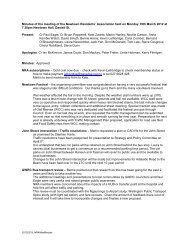Draft Town Belt Management Plan - Wellington City Council
Draft Town Belt Management Plan - Wellington City Council
Draft Town Belt Management Plan - Wellington City Council
Create successful ePaper yourself
Turn your PDF publications into a flip-book with our unique Google optimized e-Paper software.
Aro Valley War Memorial: The memorial is located on <strong>Town</strong> <strong>Belt</strong> land at the top end of Aro<br />
Street, bounded by Raroa Road and Holloway Road. The inscription reads: “Erected in memory of<br />
the boys of the Mitchelltown School and district who served abroad in the Great War 1914–<br />
1919” 25 .<br />
The school operated on nearby <strong>Town</strong> <strong>Belt</strong> land above Holloway Road from 1894 26 to 1938 27 .<br />
Ohiro Benevolent Home: Also known as the Ohiro Old People’s Home, the home was built in<br />
1892 on a 2.23ha site, partly <strong>Town</strong> <strong>Belt</strong>, above Epuni Street and, from 1904, an access-way across<br />
the <strong>Town</strong> <strong>Belt</strong> was also leased. It was transferred to the <strong>Wellington</strong> Hospital Board in 1901 and<br />
later renamed the Central Park Hospital. The hospital closed in 1975 and, until its demolition in<br />
1977, was one the last remaining examples of 19th century large wooden hospitals. Today,<br />
remnants of the buildings foundations are visible at Ohiro Park 28 29 .<br />
Central Park: Tree planting in the area between Brooklyn Road and Ohiro Road, later named<br />
Central Park, began in 1907 with encouragement from the Scenery Preservation Society. Park<br />
development began in 1913, assisted by money raised by the Citizens Easter Carnival Association.<br />
The development plan included a children’s play area, provision for future sports grounds, a small<br />
lake and various walks. The fountain and main entrance gates, donated in 1920, still remain as well<br />
as exotic trees probably dating back to the early plantings.<br />
Various parts were used intermittently as rubbish dumps between 1904 and 1959, which<br />
contributed to the filling of gullies such as that now occupied by the Renouf Tennis Centre. The<br />
park was used as a military camp during the Second World War and it underwent various<br />
refurbishments during the 1960s, 1990s and, most recently, in 2006.<br />
Newtown Park: The first sportsfield on the <strong>Town</strong> <strong>Belt</strong> was opened at Newtown Park in 1881. It<br />
included a promenade, band rotunda and formal gardens and originally included a reservoir, which<br />
later became part of the <strong>Wellington</strong> Zoological Gardens. As well as sports and amenity uses, it was<br />
used as military camps during the Boer War and both World Wars, and was a site for mass<br />
meetings, such as those held during the Tramway Strike of 1912 30 . The park was substantially<br />
remodelled between 1969 and 1972 and all that now remains of the original features are the historic<br />
conifer plantings on the bank between Newtown Park and Mt Albert Road. The Entrance gates are<br />
listed as heritage objects in the District <strong>Plan</strong>.<br />
Mt Albert signal station site: <strong>Wellington</strong>’s first signal station for shipping was built on Mt<br />
Albert in 1844. It operated until 1866, when the signal station at Beacon Hill began operation. The<br />
first signalman at Mt Albert was Robert Houghton, a master mariner. Six different shaped signals<br />
were raised on a flagstaff to denote different types of ship approaching and were lowered once the<br />
ship was inside the harbour heads. Mt Albert is now the site of two water reservoirs 31 32 .<br />
Hataitai Park: The 4.05ha area was created for sports use between 1929 and 1936, partly through<br />
excavation works carried out by relief labour and partly by using spoil from the Mt Victoria traffic<br />
tunnel, which opened in 1931. The body of 17-year-old Phyllis Symons was discovered buried in fill<br />
on the site in 1931 and a site labourer, George Coats, was convicted and hanged for the ‘<strong>Town</strong> <strong>Belt</strong><br />
murder’.<br />
Sewer Ventilation Tower: This brick structure, located close to the present-day <strong>Wellington</strong><br />
Harrier Athletic Club building on Alexandra Road, was constructed to ventilate the drainage and<br />
sewerage tunnel built beneath the ridge during the 1890s.<br />
25 Aro Valley War Memorial, http://www.nzhistory.net.nz/media/photo/aro-valley-war-memorial, (Ministry for Culture<br />
and Heritage), updated 9 November 2010.<br />
26 <strong>Town</strong> <strong>Belt</strong> <strong>Management</strong> <strong>Plan</strong> 1995, Appendix 4.<br />
27 http://archway.archives.govt.nz/ViewRelatedEntities.do?code=W3771&relatedEntity=Item<br />
28 <strong>Wellington</strong> <strong>City</strong> Archives, Photographic negative Series, Ref. No. 00158:3:7.<br />
29 <strong>Town</strong> <strong>Belt</strong> <strong>Management</strong> <strong>Plan</strong> 1995, Appendix 4.<br />
30 <strong>Town</strong> <strong>Belt</strong> <strong>Management</strong> <strong>Plan</strong> 1995, Appendix 4.<br />
31 H. Baillie, “The Early Reclamations and Harbour-works of <strong>Wellington</strong>.” Transactions and Proceedings of the Royal<br />
Society of New Zealand, Volume 55, 1924.<br />
32 “Signal Station, Mt Albert”. New Zealand Spectator and Cook's Strait Guardian, Volume I, Issue 21, 1 March 1845, 4.<br />
60<br />
<strong>Draft</strong> <strong>Town</strong> <strong>Belt</strong> <strong>Management</strong> <strong>Plan</strong> October 2012





